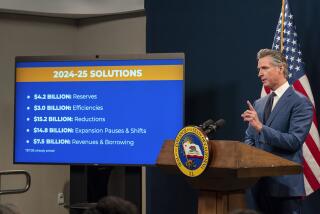State Workers Facing Layoffs
Itâs one more item on the list of state budget headaches that Arnold Schwarzenegger is inheriting: To keep the current yearâs budget in balance, the new governor may need to lay off thousands of state workers -- just in time for Christmas.
That prospect exists because the current budget, which Gov. Gray Davis signed in August, counts on saving $1.1 billion by reducing state payroll costs. The savings were supposed to come from a combination of layoffs, leaving vacant positions open and renegotiating union contracts.
During the summer, the Davis administration notified about 12,000 state workers that they could be laid off. The state has approximately 200,000 employees, not including people employed by the state university systems whose jobs are not covered by the spending-reduction plan.
Davis, who was seeking support from state workers and their unions in the recall campaign, did not follow through on the layoffs. So far, fewer than 500 workers actually have been let go, and administration officials agree that the governor has little incentive to lay off anyone else in his remaining weeks on the job.
âI donât think there is going to be much of that for the next month,â said state Personnel Director Marty Morgenstern.
That leaves Schwarzenegger with the tough choice of whether to accept a billion-dollar hole in the budget or to terminate thousands of state workers, a move that could be politically difficult and harm Californiaâs economy by increasing unemployment.
Schwarzenegger is to be sworn in as governor in mid-November. If he issues the required 30-day notices of layoffs right away, workers will lose their jobs during the holiday season. If he delays, more workers will have to be cut to accumulate the required savings by June 30, the end of the fiscal year. Already, a quarter of the fiscal year is gone, and the state is nowhere near its target for payroll reductions.
âThere are a number of issues related to the state budget that the governor-elect is going to have to address,â said H.D. Palmer, a spokesman for Schwarzenegger. âThis will be one of them.â
Palmer noted that the budget passed by the Legislature and signed by the governor last summer is law unless it is changed. It requires a reduction in state spending on its workforce.
State Budget Director Steve Peace said Friday that most departments of state government have prepared spending reduction plans that he has approved. But the Department of Personnel Administration also must review layoff plans before the final 30-day notices can go out to employees. Morgenstern said most decisions on whether to proceed with the layoffs would fall to the next administration.
âIf he came in here and continued with our procedures, some of these layoff could occur during the holidays,â Morgenstern said.
During the campaign, Schwarzenegger said one way he would cut spending would be to renegotiate pay and benefit packages for state workers. One of the planks in his 10-point plan for his first 100 days in office calls for him to ârenegotiate state employee union contracts to get better deal for taxpayers.â He has provided no details.
Jim Hard, director of the California State Employees Assn.âs civil service division, said the new two-year contract, which expires June 30, 2005, does not allow Schwarzenegger to unilaterally reopen negotiations with the union, which represents more than 90,000 state workers. Under the contract, the union -- not the governor -- has that right, he said, adding that the union would agree to do so only if it benefits the workers.
But Schwarzenegger may have some leverage in the decision: Reopening negotiations to cut pay and benefits could mean fewer layoffs.
The prospect of layoffs has created âtremendous concernâ among state workers, Hard said. âThe issue of layoffs is our No. 1 issue,â he said. âHeâs going to come in and have to deal with it. Itâs very bad for our membership. Weâre very, very concerned.â
Hard said he had sent a letter of congratulation to Schwarzenegger after the election and had offered to discuss ways to reduce the number of layoffs. To date, the union has not received a response from the governor-electâs transition staff. The association is affiliated with the Service Employees International Union, one of the biggest supporters of Davis during the recall campaign.
Unlike Davis, who drew his major financial support during the recall from unions, Schwarzenegger refused to accept donations from organized labor, noting that, as governor, he would have to negotiate with unions that represent state workers.
Economists who study Californiaâs labor force also have expressed worries about the possible effect of layoffs. The UCLA Anderson Forecast of the state economy has noted that concentrated layoffs of large numbers of state and local government employees could slow economic growth.
That, in turn, could reduce state revenues, worsening the budget picture.
Hard said officials of the State Employees Assn. assume that there will not be 12,000 layoffs. But he said the ultimate number of state workers who lose their jobs is likely to be âsignificantly larger than 500.â
The effort to reduce the state payroll got seriously underway in May, when Davis called for cutting $800 million in spending on state employee salaries as part of an overall effort to close what was then a $38-billion hole in the budget for this year. The Legislature later increased the amount of savings from state employee salaries to $1.1 billion.
Other steps that went into closing the budget gap included borrowing money by selling bonds, tripling the car tax, changing accounting procedures and cutting some spending. Of those measures, the bond sales are being challenged in court, and Schwarzenegger has said he wants to roll back the car-tax increase -- a step that would create a $4-billion budget hole.
To meet the target for payroll savings while avoiding layoffs, the Davis administration sought contract concessions from state employee unions. But that effort succeeded in saving only an estimated $185 million. As a result, if the $1.1-billion goal is to be met, layoffs of employees will have to be the main tool, according to state budget officials.
Morgenstern said court orders and staffing requirements restrict the stateâs ability to eliminate some jobs. Because of that, the chances of being laid off vary from department to department, he said.
Beyond the legal restrictions, budget cutters face political constraints as well. For instance, of the 12,000 people who were notified this summer that their jobs could be at risk, more than 3,000 work for the state prison system, which employs about 15% of the stateâs employees.
Laying off workers in the prisons could require releasing some inmates, corrections department officials have warned.
âIf I were a nurse in a state prison, I would be fairly confident they werenât going to lay me off,â Morgenstern said. But, he added, if he were an employee in an area that is ânot an essential service of government, I would be fairly uncomfortable.â
More to Read
Get the L.A. Times Politics newsletter
Deeply reported insights into legislation, politics and policy from Sacramento, Washington and beyond. In your inbox three times per week.
You may occasionally receive promotional content from the Los Angeles Times.



![[20060326 (LA/A20) -- STATING THE CASE: Marchers organized by unions, religious organizations and immigrants rights groups carry signs and chant in downtown L.A. "People are really upset that all the work they do, everything that they give to this nation, is ignored," said Angelica Salas of the Coalition of Humane Immigrant Rights. -- PHOTOGRAPHER: Photographs by Gina Ferazzi The Los Angeles Times] *** [Ferazzi, Gina -- - 109170.ME.0325.rights.12.GMF- Gina Ferazzi/Los Angeles Times - Thousands of protesters march to city hall in downtown Los Angeles Saturday, March 25, 2006. They are protesting against House-passed HR 4437, an anti-immigration bill that opponents say will criminalize millions of immigrant families and anyone who comes into contact with them.]](https://ca-times.brightspotcdn.com/dims4/default/34f403d/2147483647/strip/true/crop/1983x1322+109+0/resize/840x560!/quality/75/?url=https%3A%2F%2Fcalifornia-times-brightspot.s3.amazonaws.com%2Fzbk%2Fdamlat_images%2FLA%2FLA_PHOTO_ARCHIVE%2FSDOCS%2854%29%2Fkx3lslnc.JPG)






